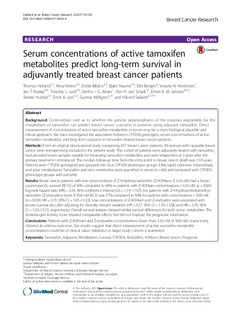| dc.contributor.author | Helland, Thomas | |
| dc.contributor.author | Henne, Nina | |
| dc.contributor.author | Bifulco, Ersilia | |
| dc.contributor.author | Naume, Bjørn | |
| dc.contributor.author | Borgen, Elin | |
| dc.contributor.author | Kristensen, Vessela N. | |
| dc.contributor.author | Kvaløy, Jan Terje | |
| dc.contributor.author | Lash, Timothy L | |
| dc.contributor.author | Grenaker, Grethe Irene | |
| dc.contributor.author | van Schaik, RHN | |
| dc.contributor.author | Janssen, Emiel | |
| dc.contributor.author | Hustad, Steinar | |
| dc.contributor.author | Lien, Ernst Asbjørn | |
| dc.contributor.author | Mellgren, Gunnar | |
| dc.contributor.author | Søiland, Håvard | |
| dc.date.accessioned | 2018-01-12T10:13:49Z | |
| dc.date.available | 2018-01-12T10:13:49Z | |
| dc.date.created | 2018-01-11T14:10:32Z | |
| dc.date.issued | 2017 | |
| dc.identifier.citation | Søiland, H. et al. (2017) Serum concentrations of active tamoxifen metabolites predict long-term survival in adjuvantly treated breast cancer patients. Breast Cancer Research, 19(125) | nb_NO |
| dc.identifier.issn | 1465-542X | |
| dc.identifier.uri | http://hdl.handle.net/11250/2477162 | |
| dc.description.abstract | Background Controversies exist as to whether the genetic polymorphisms of the enzymes responsible for the metabolism of tamoxifen can predict breast cancer outcome in patients using adjuvant tamoxifen. Direct measurement of concentrations of active tamoxifen metabolites in serum may be a more biological plausible and robust approach. We have investigated the association between CYP2D6 genotypes, serum concentrations of active tamoxifen metabolites, and long-term outcome in tamoxifen treated breast cancer patients. Methods From an original observational study comprising 817 breast cancer patients, 99 women with operable breast cancer were retrospectively included in the present study. This cohort of patients were adjuvantly treated with tamoxifen, had provided serum samples suitable for measuring tamoxifen metabolites, and were relapse-free at 3 years after the primary treatment commenced. The median follow-up time from this entry point to breast cancer death was 13.9 years. Patients were CYP2D6 genotyped and grouped into four CYP2D6 phenotype groups (Ultra rapid, extensive, intermediate, and poor metabolizers). Tamoxifen and nine metabolites were quantified in serum (n = 86) and compared with CYP2D6 phenotype groups and outcome. Results Breast cancer patients with low concentrations of Z-4-hydroxy-tamoxifen (Z-4OHtam; ≤ 3.26 nM) had a breast cancer-specific survival (BCSS) of 60% compared to 84% in patients with Z-4OHtam concentrations > 3.26 nM (p = 0.020, log-rank hazard ratio (HR) = 3.56, 95% confidence interval (CI) = 1.14–11.07). For patients with Z-4-hydroxy-N-desmethyl-tamoxifen (Z-endoxifen) levels ≤ 9.00 nM BCSS was 57% compared to 84% for patients with concentrations > 9.00 nM (p = 0.029, HR = 3.73, 95% CI = 1.05–13.22). Low concentrations of Z-4OHtam and Z-endoxifen were associated with poorer survival also after adjusting for clinically relevant variables (HR = 4.27, 95% CI = 1.35–13.58, and HR = 3.70, 95% CI = 1.03–13.25, respectively). Overall survival analysis showed similar survival differences for both active metabolites. The Antiestrogen Activity Score showed comparable effects, but did not improve the prognostic information. Conclusions Patients with Z-4OHtam and Z-endoxifen concentrations lower than 3.26 nM or 9.00 nM, respectively, showed an adverse outcome. Our results suggest that direct measurement of active tamoxifen metabolite concentrations could be of clinical value. Validation in larger study cohorts is warranted. | nb_NO |
| dc.language.iso | eng | nb_NO |
| dc.publisher | BioMed Central | nb_NO |
| dc.relation.uri | https://breast-cancer-research.biomedcentral.com/articles/10.1186/s13058-017-0916-4 | |
| dc.rights | Navngivelse 4.0 Internasjonal | * |
| dc.rights.uri | http://creativecommons.org/licenses/by/4.0/deed.no | * |
| dc.subject | helsefag | nb_NO |
| dc.subject | brystkreft | nb_NO |
| dc.subject | overlevelse | nb_NO |
| dc.subject | prognose | nb_NO |
| dc.title | Serum concentrations of active tamoxifen metabolites predict long-term survival in adjuvantly treated breast cancer patients | nb_NO |
| dc.type | Journal article | nb_NO |
| dc.type | Peer reviewed | nb_NO |
| dc.description.version | publishedVersion | nb_NO |
| dc.rights.holder | © The Author(s) 2017 | nb_NO |
| dc.subject.nsi | VDP::Medisinske Fag: 700::Klinisk medisinske fag: 750::Onkologi: 762 | nb_NO |
| dc.source.volume | 19 | nb_NO |
| dc.source.journal | Breast Cancer Research | nb_NO |
| dc.source.issue | 125 | nb_NO |
| dc.identifier.doi | 10.1186/s13058-017-0916-4 | |
| dc.identifier.cristin | 1540879 | |
| cristin.unitcode | 217,8,2,0 | |
| cristin.unitname | Institutt for matematikk og naturvitenskap | |
| cristin.ispublished | true | |
| cristin.fulltext | original | |
| cristin.qualitycode | 1 | |

